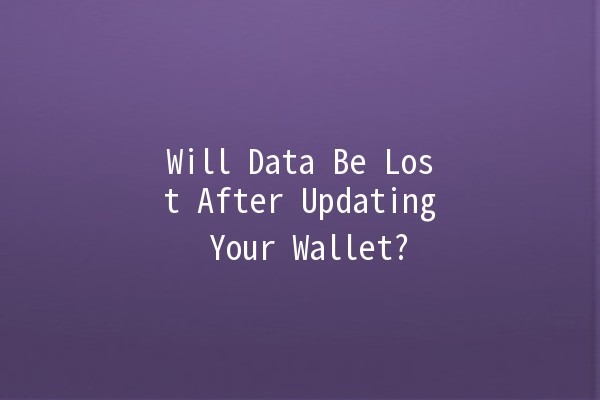
In the world of digital finance, wallets play a crucial role in managing our cryptocurrency assets. As we navigate through the complexities of wallets, app updates, and security features, a common concern arises: "Will data be lost after updating my wallet?" This article delves deep into this topic, offering practical insights, addressing fears, and dispelling myths. Additionally, we provide productivity tips to help you manage your wallet and digital assets more effectively.
Understanding Wallet Updates
When it comes to updating digital wallets, many users experience anxiety regarding potential data loss. Wallet updates are typically intended to enhance functionality, fix bugs, and improve security measures. However, concerns remain about whether these updates affect the stored data, including transaction history and private keys.
The Purpose of Wallet Updates

These updates usually do not affect your stored data, but precautions should be taken to ensure data integrity.
Does an Update Risk Data Loss? 🧐
Understanding Data Storage
Data stored in cryptocurrency wallets falls into two categories:
OnChain Data: This is recorded on the blockchain and includes transaction history and balances. This data cannot be lost as it is stored across numerous nodes in the network.
OffChain Data: This includes personal settings, wallet addresses, and user preferences, which can be stored in the wallet app.
While onchain data remains intact during updates, offchain data may potentially be impacted if the update process is not handled correctly.
Key Considerations to Avoid Data Loss
Before an update, ensure you have a recent backup of your wallet. Most wallets provide an easy way to back up your data, often generating a recovery phrase or seed.
Example: If you use a software wallet, write down your recovery seed phrase and store it in a secure location.
Always adhere to official guidelines provided by the wallet developers when performing updates.
Example: If your wallet recommends uninstalling the old version before installing the new one, do so to minimize risks.
Download updates directly from the official website or app store to avoid malicious versions that might compromise your data.
Example: If you use a mobile wallet, always check for updates on the Apple App Store or Google Play Store.
Developers often outline what has changed in new versions, including potential impacts on data storage.
Example: Check if the update includes changes in encryption methods, as this could influence how your data is handled.
Ensure your operating system and antivirus software are current to mitigate external threats during the updating process.
Example: Update your computer or smartphone software regularly to ensure all security patches are installed.
Five Practical Productivity Tips for Wallet Management 💪
Managing your digital wallet effectively can enhance your overall experience. Here are five practical tips to boost your productivity:
Explanation:
Frequent monitoring allows you to keep track of your spending and gains, providing better control over your financial decisions.
Application Example:
Create a monthly review schedule where you analyze your transaction history, identify trends, and make informed investment decisions.
Explanation:
Many wallets and exchanges offer the option to set price alerts for your assets.
Application Example:
Utilize this feature to notify you of significant price fluctuations, ensuring you can make timely decisions regarding buying or selling your assets.
Explanation:
Adding an extra layer of security ensures that even if your password is compromised, your wallet remains protected.
Application Example:
Enable 2FA on your wallet and any associated exchange accounts to enhance security.
Explanation:
Regular updates help to secure your wallet against vulnerabilities.
Application Example:
Create a calendar reminder for periodic checks on your wallet and software updates, ensuring you never miss essential upgrades.
Explanation:
The more you know about cryptocurrency security, the better equipped you will be to manage your wallet.
Application Example:
Allocate time each week to read articles, watch videos, or attend webinars on cryptocurrency security best practices.
Common Concerns About Wallet Updates
Private keys are fundamental to accessing your cryptocurrencies. Most updates do not alter your private keys as they are securely stored within the wallet. Always ensure you have backed up your keys before any significant updates as a precaution.
In rare cases, wallets may experience compatibility issues postupdate. If you cannot access your wallet, ensure you follow the recovery processes outlined by the developers. Using your recovery phrase can often restore access to your account.
Wallets with automatic updates can be safe, but it's crucial to trust the developers and ensure they release quality updates. Regularly check the updates they offer and the community's feedback to ascertain their reliability.
While you can skip updates, doing so may leave your wallet vulnerable to security threats. Regular updates are necessary for maintaining the integrity and security of your wallet.
Regular backups are essential. Consider backing up your wallet after any significant action, such as completing a large transaction or after updating the wallet software. This will help ensure your data is current.
Most wallet updates do not affect connections to exchanges. However, it’s wise to confirm this after an update by testing any connections to ensure everything functions as expected.
Updating your wallet is an essential practice to maintain security, improve performance, and enhance usability. While worries about data loss are common, following essential precautions can help ensure your data remains intact. By implementing best practices for wallet management, you can not only safeguard your assets but also cultivate a more productive approach to using digital finance tools. The key is to always remain vigilant, educated, and prepared for each update.
As you navigate this evolving landscape, your knowledge and proactive measures will be invaluable in protecting and managing your digital assets more effectively.

